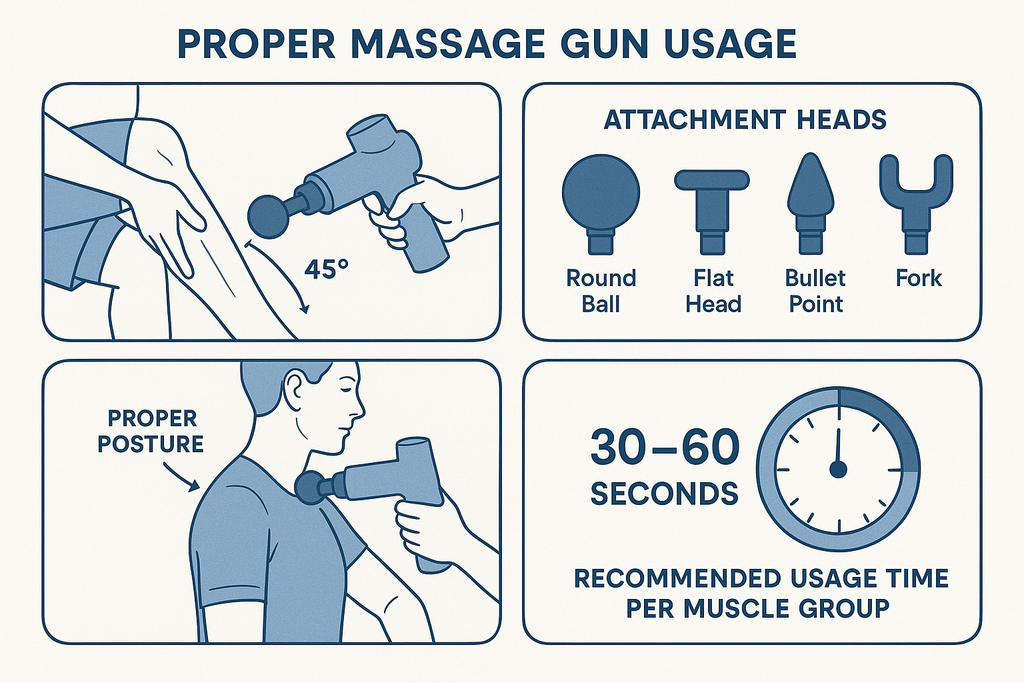How to Use a Massage Gun for Faster Muscle Recovery at Home

Muscle soreness is something almost everyone experiences—from athletes after intense workouts to desk workers dealing with tension from sitting too long. Thankfully, technology has brought us a powerful tool once reserved for professional therapists: the massage gun. Compact, convenient, and surprisingly affordable, this device is transforming the way people manage recovery and relaxation at home.

In this guide, we’ll explore how to use a massage gun for muscle recovery, the benefits of using a massage gun, and how you can make it part of your daily wellness routine without stepping foot in a spa or clinic.
Understanding the Power Behind Massage Guns
Massage guns, also known as percussion or deep tissue massagers, deliver rapid bursts of pressure to targeted areas of the body. These vibrations penetrate deep into muscle fibers, increasing blood flow and reducing tightness—mimicking the results of a professional deep-tissue massage.
When you apply the device to sore muscles, it stimulates your nervous system and fascia (the connective tissue surrounding muscles). This not only helps relieve soreness but also improves flexibility and promotes faster recovery after physical activity.
Unlike static massage tools like foam rollers, a massage gun allows precise targeting. You can adjust the speed, pressure, and angle to match your body’s needs, making it a versatile and customizable recovery tool for anyone—from runners to office workers.
The Benefits of Using a Massage Gun
The benefits of using a massage gun go far beyond easing soreness. Let’s look at why these handheld devices have become essential recovery companions in homes and gyms around the world.
1. Speeds Up Muscle Recovery
After exercise, your muscles accumulate microscopic tears and lactic acid buildup, causing stiffness and fatigue. Using a massage gun helps flush out metabolic waste and promotes fresh oxygen and nutrient delivery to the tissue. This accelerates repair and reduces downtime between workouts.
2. Relieves Pain and Tension
For anyone suffering from chronic muscle tension, knots, or even stress-related stiffness, percussive therapy provides instant relief. The rhythmic pressure encourages muscle relaxation and reduces pain signals from the nervous system—ideal for tight shoulders, lower back tension, and neck stiffness.
3. Improves Circulation
Better circulation means faster healing. When you use a massage gun, it encourages blood vessels to dilate, enhancing circulation in the treated area. Improved blood flow not only supports recovery but also helps your muscles feel looser, warmer, and more flexible.
4. Enhances Mobility and Flexibility
Tight muscles restrict movement and can increase the risk of injury. Regularly massaging with a percussion device helps release fascial adhesions, improve joint range of motion, and restore elasticity to the muscles—essential for athletes and anyone seeking greater freedom of movement.
5. Reduces Stress and Promotes Relaxation
Beyond its physical benefits, using a massage gun has a calming psychological effect. The rhythmic vibrations can lower cortisol levels and trigger the release of endorphins—your body’s natural “feel-good” hormones. Many users report that a short massage session before bed helps them unwind and sleep better.
When Should You Use a Massage Gun?
One of the best things about a massage gun is its flexibility—it fits into multiple stages of your wellness routine.
-
Before a workout: A 5–10 minute session helps warm up muscles, increase blood flow, and prepare your body for movement.
-
After a workout: Post-exercise, a gentle massage helps flush lactic acid, reduce soreness, and promote faster muscle recovery.
-
On rest days: Even when you’re not training, light percussive therapy can maintain mobility and keep your body relaxed.
-
For tension relief: Use the massage gun anytime you feel stiffness in your neck, back, or shoulders—especially after sitting for long periods.
Remember: moderation is key. While massage guns are safe, overusing them on one spot can cause bruising or irritation. Always listen to your body.
How to Use a Massage Gun for Muscle Recovery
If you’ve just purchased your first massage gun, learning how to use it properly is essential for safe and effective results. Below, we’ll walk through each step of using a massage gun at home for maximum benefit.
1. Choose the Right Attachment Head
Most massage guns come with interchangeable heads for targeting different muscle groups:
-
Round Head: Best for large muscle groups such as the quads, hamstrings, and glutes.
-
Flat Head: Ideal for denser areas like the chest or back.
-
Bullet Head: Used for deep, precise pressure on knots or trigger points.
-
Fork Head: Great for the neck and spine, fitting around tendons without pressing directly on bones.
Pick the attachment that feels most comfortable for your desired area and start with the lowest intensity setting.
2. Start Slow and Gentle
Begin with a low speed or intensity setting to warm up the area. Move the massage gun slowly over your muscles, letting it glide rather than pressing too hard. The goal is to loosen tension—not to bruise the tissue.
3. Maintain Constant Movement
Avoid keeping the massage gun on one spot for too long. Move it in slow, steady strokes along the length of the muscle. Spend about 30–60 seconds per area to improve circulation and ease tightness.
4. Focus on Sore or Tight Areas
When you find a particularly tense spot, linger for a few extra seconds, letting the percussive motion do the work. You may feel mild discomfort, but it shouldn’t be painful. If you experience sharp pain, stop immediately and reduce intensity.
5. Adjust Pressure and Angle
Different muscle groups respond to varying levels of pressure. Larger muscles like the thighs can handle more force, while smaller or sensitive areas like the neck require gentler touch. Adjust your grip and the angle of the massage gun for comfort and control.
6. Post-Session Stretching
For best results, follow up your massage session with light stretching. This combination enhances flexibility and locks in the recovery benefits, helping your body move fluidly and naturally.
How Long Should You Use a Massage Gun?
Duration depends on the area and your personal tolerance. For general muscle recovery:
-
Large muscles (legs, back, glutes): 1–2 minutes per group
-
Smaller muscles (arms, calves, neck): 30–60 seconds per group
-
Warm-up sessions: 5–10 minutes total before a workout
-
Cool-down sessions: 10–15 minutes after exercise
Short, consistent use is more effective than long, infrequent sessions. Incorporating your massage gun into a daily routine ensures cumulative benefits over time.
Combining a Massage Gun with Other Recovery Methods
To amplify your recovery results, combine your massage gun therapy with complementary techniques: 
Hydration and Nutrition
Muscle repair relies heavily on hydration and nutrient intake. Drinking plenty of water after using your massage gun helps flush toxins released from the muscles, while a protein-rich meal supports repair and growth.
Stretching and Mobility Work
Using a massage gun before stretching helps warm up the tissue, making your stretches more effective. Focus on flexibility exercises for tight areas after each massage session.
Cold or Heat Therapy
Alternating between hot and cold treatments with your massage gun use can further reduce inflammation and enhance circulation.
Adequate Sleep
Rest is where true recovery happens. Incorporate massage therapy before bedtime to promote relaxation and deeper sleep—vital for muscle growth and hormonal balance.
Common Mistakes to Avoid
Even though massage guns are simple to use, a few common mistakes can limit their effectiveness or cause discomfort.
Pressing Too Hard
More pressure doesn’t equal faster recovery. The percussion is already strong enough to reach deep muscle tissue—pressing harder only risks bruising or nerve irritation.
Using It on Bones or Joints
Massage guns are meant for muscles, not bones. Avoid using them directly on joints, the spine, or neck vertebrae.
Skipping Warm-Up
If your muscles are cold, start gently or warm up first. Jumping straight into deep massage can increase soreness.
Ignoring Pain Signals
If the area becomes red, painful, or numb, stop immediately. Always let your body guide the intensity and duration of your massage.
Who Can Benefit from a Massage Gun?
Massage guns aren’t just for athletes—they’re beneficial for almost everyone.
-
Athletes & Gym-Goers: Ideal for quick recovery between training sessions.
-
Office Workers: Relieves stiffness caused by sitting and poor posture.
-
Older Adults: Helps maintain circulation, joint mobility, and relaxation.
-
Travelers: Reduces leg fatigue and tightness from long flights.
-
Chronic Pain Sufferers: Provides gentle, drug-free relief for daily aches and tension.
If you have medical conditions like deep vein thrombosis, fractures, or severe inflammation, consult your doctor before using one.
The Science Behind Percussive Therapy
Research into percussive therapy—the science behind massage guns—is growing fast. Studies suggest that vibration and percussion increase blood flow, improve range of motion, and reduce muscle soreness after intense physical activity.
A 2020 study in the Journal of Clinical Medicine found that percussive therapy before exercise helped reduce muscle stiffness, while post-exercise sessions improved flexibility and decreased delayed-onset muscle soreness (DOMS). Another review from Frontiers in Physiology highlighted its role in improving lymphatic drainage, helping the body recover more efficiently.
In simpler terms: using a massage gun regularly not only helps your muscles feel better—it may actually make them perform better too.
Creating a Home Recovery Routine
Building a consistent self-care routine with your massage gun ensures you get the most from its benefits. Here’s a simple framework you can follow:
-
Morning (5 minutes): Light massage on shoulders, neck, and back to loosen muscles before starting your day.
-
Pre-Workout (10 minutes): Use the round or flat head to warm up large muscle groups.
-
Post-Workout (10–15 minutes): Focus on sore areas—quads, hamstrings, calves—to flush lactic acid.
-
Evening (5–10 minutes): Gentle session on the neck and upper back to relieve tension and prepare for rest.
Consistency matters more than duration. Even short sessions can make a significant difference in your overall comfort and recovery.
Maintaining Your Massage Gun
Like any wellness tool, proper care extends the life of your device. Keep it clean by wiping attachments with a mild disinfectant after each use. Avoid overcharging or letting the battery fully drain repeatedly. Store it in a cool, dry place to preserve motor quality.
Replacing attachments as they wear ensures consistent pressure and hygiene. If you use your massage gun daily, inspect it every few months for loose fittings or signs of wear.
Choosing the Right Massage Gun for You
Not all massage guns are built the same. Here are a few factors to consider when shopping for one:
-
Power and Speed Settings: Look for models with variable speeds to suit sensitive and tough areas alike.
-
Battery Life: At least 2–3 hours per charge is ideal for home use.
-
Noise Level: Quieter models enhance relaxation, especially if you plan to use it before sleep.
-
Attachment Variety: The more heads included, the better you can customize your massage.
-
Weight and Grip: Lightweight designs are easier to maneuver for self-massage.
Top-selling options such as the Allgri Mini Deep Tissue Massage Gun combine strong percussion power, compact design, and quiet performance—making them perfect for home recovery.
Final Thoughts: Bringing Recovery Home
Learning how to use a massage gun for muscle recovery can change the way you approach fitness and wellness. It’s a small investment with significant returns—faster recovery, reduced pain, improved mobility, and enhanced overall wellbeing.
Whether you’re an athlete chasing performance goals or simply looking to ease daily tension, a massage gun gives you control over your recovery, right from home.
As you explore the benefits of using a massage gun, remember that consistency, gentleness, and awareness are your best tools. Over time, you’ll develop a deeper understanding of your body’s needs—and find that recovery is no longer a chore, but a ritual of self-care and empowerment.

Leave a comment